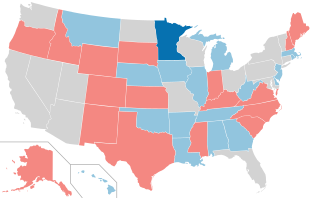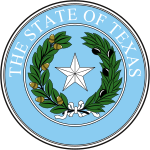
The 1990 United States Senate elections were held on Tuesday, November 6, 1990, with the 33 seats of Class 2 contested in regular elections. Special elections were also held to fill vacancies. The Democratic Party increased its majority with a net gain of one seat from the Republican Party. The election took place in the middle of President George H. W. Bush's term, and, as with most other midterm elections, the party not holding the presidency gained seats in Congress.

The 1988 United States Senate elections were elections for the United States Senate. Held on November 8, the 33 seats of Class 1 were contested in regular elections. In spite of the Republican victory by George H. W. Bush in the presidential election, the Democrats gained a net of one seat in the Senate. Seven seats changed parties, with four incumbents being defeated. The Democratic majority in the Senate increased by one to 55–to–45.

The 1986 United States Senate elections were elections for the United States Senate. Held on November 4, in the middle of Ronald Reagan's second presidential term, the 34 seats of Class 3 were contested in regular elections. The Republicans had to defend an unusually large number of freshman Senate incumbents who had been elected on President Ronald Reagan's coattails in 1980. Democrats won a net of eight seats, defeating seven freshman incumbents, picking up two Republican-held open seats, and regaining control of the Senate for the first time since January 1981. This remains the most recent midterm election cycle in which the sitting president's party suffered net losses while still flipping a Senate seat.

The 1984 United States Senate elections were held on November 6, with the 33 seats of Class 2 contested in regular elections. They coincided with the landslide re-election of President Ronald Reagan in the presidential election. In spite of the lopsided presidential race, Reagan's Republican Party suffered a net loss of two Senate seats to the Democrats, although it retained control of the Senate with a reduced 53-47 majority. Democrats defeated incumbents in Illinois and Iowa, and won an open seat in Tennessee, while Republicans defeated an incumbent in Kentucky.

The 1978 United States Senate elections were held on November 7, in the middle of Democratic President Jimmy Carter's term. The 33 seats of Class 2 were contested in regular elections. Special elections were also held to fill vacancies.

The 1976 United States Senate elections was an election for the United States Senate. Held on November 2, the 33 seats of Class 1 were contested in regular elections. They coincided with Democrat Jimmy Carter's presidential election and the United States Bicentennial celebration. Although almost half of the seats decided in this election changed parties, Carter's narrow victory did not provide coattails for the Democratic Party. Each party flipped seven Senate seats, although, one of the seats flipped by Democrats was previously held by a Conservative.

The 1970 United States Senate elections was an election for the United States Senate. It took place on November 3, with the 33 seats of Class 1 contested in regular elections. Special elections were also held to fill vacancies. These races occurred in the middle of Richard Nixon's first term as president. The Democrats lost a net of three seats, while the Republicans and the Conservative Party of New York picked up one net seat each, and former Democrat Harry F. Byrd Jr. was re-elected as an independent.

The 1958 United States Senate elections were elections for the United States Senate which occurred in the middle of President Dwight D. Eisenhower's second term. Thirty-two seats of Class 1 were contested in regular elections, the new state of Alaska held its first Senate elections for its Class 2 and 3 seats, and two special elections were held to fill vacancies.

The 1952 United States Senate elections was an election for the United States Senate which coincided with the election of Dwight D. Eisenhower to the presidency by a large margin. The 32 Senate seats of Class 1 were contested in regular elections, and three special elections were held to fill vacancies. The Republicans took control of the Senate by managing to make a net gain of two seats. However, Wayne Morse (R-OR) became an independent forcing Republicans to rely on Vice President Richard Nixon's tie-breaking vote, although Republicans maintained a 48-47-1 plurality. Throughout the next Congress, Republicans were able to restore their 49-46-1 majority. This was the third time, as well as second consecutive, in which a sitting Senate leader lost his seat.

The 2008 United States Senate election in Texas was held on November 4, 2008. Incumbent Republican John Cornyn defeated Democratic nominee Rick Noriega, a member of the Texas House of Representatives, to win re-election to a second term in office.

The 1984 United States Senate election in Texas was held on November 6, 1984. Incumbent Republican U.S. Senator John Tower decided to retire, instead of seeking a fifth term. Republican Phil Gramm won the open seat.

The 1982 United States Senate election in Texas took place on November 2, 1982. Incumbent Democratic U.S. Senator Lloyd Bentsen won re-election to a third term in office, defeating Republican U.S. Representative James M. Collins.

The 1942 United States Senate election in Texas was held on November 3, 1942. Incumbent Democratic U.S. Senator W. Lee "Pappy" O'Daniel was re-elected to a second term.

The 1916 United States Senate election in Texas was held on November 7, 1916. Incumbent Democratic U.S. Senator Charles Culberson was re-elected to a fourth term in office. Culberson survived a challenge from former Governor Oscar Colquitt in the Democratic primary, then easily won the general election.

The 1922 United States Senate election in Texas was held on November 7, 1922. Incumbent Democratic U.S. Senator Charles Culberson ran for re-election to a fifth term, but lost the Democratic primary. A runoff was held between former Governor Pa Ferguson and Railroads Commissioner Earle Bradford Mayfield.

The 1928 United States Senate election in Texas was held on November 6, 1928. Incumbent Democratic U.S. Senator Earle Mayfield ran for re-election to a second term.

The 1940 United States Senate election in Texas was held on November 5, 1940. Incumbent Democratic U.S. Senator Tom Connally was re-elected to his third term in office, with only minor opposition in the Democratic primary and general elections.

The 1946 United States Senate election in Texas was held on November 5, 1946. Incumbent Democratic U.S. Senator Tom Connally was re-elected to his fourth term in office, with only minor opposition in the Democratic primary and general elections.

The 1952 United States Senate election in Texas was held on November 4, 1952. Incumbent Democratic U.S. Senator Tom Connally did not run for re-election to a fifth term.
Democrat William Proxmire won a special election to fill the vacancy created by the death of Senator Joseph R. McCarthy (R-WI). Also, Price Daniel (D-TX) left the Senate to become governor of Texas, and Democrat Ralph Yarborough won a special election for that Senate seat. The Democrats thus made a net gain of one seat. However, Congress was out of session at the time of the Democratic gain in Wisconsin, and the Republicans gained a Democratic-held seat only weeks after the next session started, when Republican John D. Hoblitzell Jr. was appointed to fill the vacancy created by the death of Senator Matthew M. Neely (D-WV).























